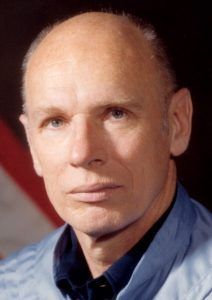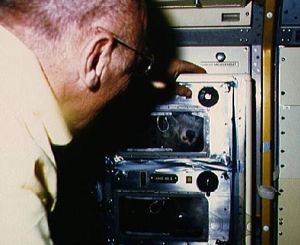
Home - Search - Browse - Alphabetic Index: 0- 1- 2- 3- 4- 5- 6- 7- 8- 9
A- B- C- D- E- F- G- H- I- J- K- L- M- N- O- P- Q- R- S- T- U- V- W- X- Y- Z
Thornton, William Edgar
 Thornton Bill Credit: www.spacefacts.de |
Status: Inactive; Active 1967-1994. Born: 1929-04-14. Spaceflights: 2 . Total time in space: 13.05 days. Birth Place: Faison, North Carolina.
Educated UNC.
Official NASA Biography
NAME: William Edgar Thornton (M.D.)
NASA Astronaut
BIRTHPLACE AND DATE: Born in Faison, North Carolina, on April 14, 1929.
PHYSICAL DESCRIPTION: Blond hair; blue eyes; 6 feet; 200 pounds.
EDUCATION: Attended primary and secondary schools in Faison, North Carolina; received a bachelor of science degree in Physics and a doctorate in Medicine from the University of North Carolina in 1952 and 1953, respectively.
MARITAL STATUS: Married to the former Elizabeth Jennifer Fowler of Hertfordshire, England.
CHILDREN: William Simon, March 15, 1959; James Fallon, January 4, 1961.
SPECIAL HONORS: Recipient of the Air Force Legion of Merit (1956); the NASA Exceptional Service Medal (1972); the NASA Exceptional Scientific Achievement Medal (1974); the American Astronautical Society's Melbourne W. Boynton Award for 1975 (1977); two NASA Space Flight Medals (1983, 1985); the University of North Carolina Distinguished Alumni Award (1983); the Aerospace Medical Association Randy Lovelace Award (1984); the AIAA Jeffries Medical Research Award (1985); the Association of Military Surgeons of the United States Kern Award (1986); the NASA Exceptional Engineering Achievement Award (1988).
EXPERIENCE: Following graduation from the University of North Carolina and having completed Air Force ROTC training, Thornton served as officer-in-charge of the Instrumentation Lab at the Flight Test Air Proving Ground. He later became a consultant to Air Proving Ground Command.
As chief engineer of the electronics division of the Del Mar Engineering Labs at Los Angeles from 1956 to 1959, he also organized and directed its Avionics Division. He returned to the University of North Carolina Medical School in 1959, graduated in 1963, and completed internship training in 1964 at the Wilford Hall USAF Hospital at Lackland Air Force Base, San Antonio, Texas.
He returned to active duty with the United States Air Force and was then assigned to the USAF Aerospace Medical Division, Brooks Air Force Base, San Antonio, where he completed the Primary Flight Surgeon's training in 1964. It was during his two-year tour of duty there that he became involved in space medicine research and subsequently applied and was selected for astronaut training. Dr. Thornton developed and designed the first mass measuring devices for space, which remain in use today.
He has logged over 2,500 hours pilot flying time in jet aircraft, is currently a Clinical Assistant Professor in the Department of Medicine, University of Texas Medical Branch, Galveston, Texas, and is an adjunct Professor at University of Houston, Clear Lake.
NASA EXPERIENCE: Dr. Thornton was selected as a scientist-astronaut by NASA in August 1967. He completed the required flight training at Reese Air Force Base, Texas. Dr. Thornton was physician crew member on the highly successful Skylab Medical Experiments Altitude Test (SMEAT) -- a 56-day simulation of a Skylab mission enabling crewmen to collect medical experiments baseline data and evaluate equipment, operations, and procedures. He was also the mission specialist on SMD III, a simulation of a Spacelab life sciences mission.
He was a member of the astronaut support crew for the Skylab 2, 3, and 4 missions, and principal investigator for Skylab experiments on mass measurement, anthropometric measurements, hemodynamics, and human fluid shifts and physical conditioning. He first documented the shift and loss of fluid changes in body posture size and shape, including increase in height and the rapid loss of muscle strength and mass in space flight.
As a member of the Astronaut Office Operations Missions Development group, Dr. Thornton was responsible for developing crew procedures and techniques for deployable payloads, and for maintenance of crew conditions in flight. He developed advanced techniques for, and made studies in kinesiology and kinesimetry related to space operations.
During STS operations he continued physiological investigations in the cardiovascular and musculoskeletal and neurological areas. He developed the Shuttle treadmill for in-flight exercise and several other on-board devices. His work concentrated on the space adaptation syndrome, with relevant investigations on STS-4, STS-5, STS-6, STS-7, and STS-8.
Dr. Thornton holds more than 35 issued patents that range from military weapons systems through the first real-time EKG computer analysis. Space related items include the first inflight mass measurement devices, shock and vibration isolation systems, an improved waste collection system, an improved Lower Body Negative Pressure (LBNP) apparatus, and others.
Dr. Thornton first served as a mission specialist on STS-8, which launched from Kennedy Space Center, Florida, on August 30, 1983. This was the third flight for the Orbiter Challenger and the first mission with a night launch and night landing. During the flight Dr. Thornton made almost continuous measurements of and investigations in adaptation of the human body to weightlessness, especially of the nervous system and of the space adaptation syndrome. This was a continuation of his previous work in these areas. Much of the equipment used was designed and developed by Dr. Thornton. STS-8 completed 98 orbits of the Earth in 145 hours before landing at Edwards Air Force Base, California, on September 5, 1983.
On his second flight, Dr. Thornton was a mission specialist on STS 51-B, the Spacelab-3 science mission, which launched from Kennedy Space Center, Florida, on April 29, 1985. During this mission, Dr. Thornton was responsible for the first animal payload in manned flight and other medical investigations. After completing 110 orbits of the earth, the Orbiter Challenger landed at Edwards Air Force Base, California, on May 6, 1985. With the completion of this flight, Dr. Thornton logged over 313 hours in space.
Dr. Thornton continues his work in space medicine while awaiting his next flight opportunity.
CURRENT ASSIGNMENT: Dr. Thornton is currently working on problems relative to extending mission durations in the Space Shuttle, in Space Station, and in space exploration, and has designed the necessary exercise and other hardware to support such missions. He continues analysis and publication of results from studies of neurological adaptation, and is currently studying neuromuscular inhibition following flight, osteoporosis in space and on earth, and post flight orthostasis. He has completed designs for exercise and other countermeasure equipment for the Extended Duration Orbiter (EDO), and for Space Station Freedom, including improved treadmills, rowing machines, isotonic exercise devices, and a bicycle. Much of this is currently scheduled for flight.
FEBRUARY 1992
More at: Thornton, Bill.
Family: Astronaut. Country: USA. Flights: STS-8, STS-51-B. Projects: STS. Agency: USAF. Bibliography: 12, 6107.
 | STS-51-B Astronaut William Thornton observes monkey in the RAHF Credit: NASA |
1929 April 14 - .
- Birth of Dr William Edgar 'Bill' Thornton - . Nation: USA. Related Persons: Thornton, Bill. American physician mission specialist astronaut 1967-1994. 2 spaceflights, 13.1 days in space. Flew to orbit on STS-8 (1983), STS-51B..
1967 August 4 - .
- NASA Astronaut Training Group 6 selected. - .
Nation: USA.
Related Persons: Allen,
Chapman,
England,
Henize,
Holmquest,
Lenoir,
Llewellyn,
Musgrave,
O Leary,
Parker,
Thornton, Bill.
The group was selected to provide additional scientist-astronauts for Apollo lunar landing and earth-orbit space station missions.. Qualifications: Doctorate in natural sciences, medicine, or engineering. Under 35 years old, under 183 cm height, excellent health. US citizen or willing to become a naturalized citizen.. In response to the poor result of the first scientist-astronaut selection, NASA went ahead with a second round of selections. 923 people applied, of which 69 selected by the National Academy of Sciences for NASA physical and mental evaluation. By the time the new astronauts reported, ambitious Apollo Applications plans had been scrapped, leading to their nickname 'The Excess Eleven'. Seven stayed on through the 1970's and finally got to fly aboard the space shuttle.
1983 August 30 - . 06:32 GMT - . Launch Site: Cape Canaveral. Launch Complex: Cape Canaveral LC39A. Launch Platform: MLP2. LV Family: Shuttle. Launch Vehicle: Space Shuttle.
- STS-8 - .
Call Sign: Challenger. Crew: Bluford,
Brandenstein,
Gardner,
Thornton, Bill,
Truly.
Payload: Challenger F03 / PFTA. Mass: 13,642 kg (30,075 lb). Nation: USA.
Related Persons: Bluford,
Brandenstein,
Gardner,
Thornton, Bill,
Truly.
Agency: NASA Houston.
Program: STS.
Class: Manned.
Type: Manned spaceplane. Flight: STS-8.
Spacecraft Bus: Shuttle.
Spacecraft: Challenger.
Duration: 6.05 days. Decay Date: 1983-09-05 . USAF Sat Cat: 14312 . COSPAR: 1983-089A. Apogee: 313 km (194 mi). Perigee: 306 km (190 mi). Inclination: 28.50 deg. Period: 90.70 min.
First night launch and night landing. Deployed Insat 1B. Payloads: Deployment of INSAT (lndia communica-tion satellite) with Payload Assist Module (PAM)-D, Payload Flight Test Article (PFTA)/ Payload Deployment Retrieval System (PDRS), Continuous Flow Electrophoresis (CFES), biomedical experiments. 250,000 express mail envelopes with special cachet for U.S. Postal Service were carried for a first-day cover.
1983 September 5 - .
- Landing of STS-8 - . Return Crew: Bluford, Brandenstein, Gardner, Thornton, Bill, Truly. Nation: USA. Related Persons: Bluford, Brandenstein, Gardner, Thornton, Bill, Truly. Program: STS. Flight: STS-8. STS-8 landed at 07:40 GMT. .
1985 April 29 - . 16:02 GMT - . Launch Site: Cape Canaveral. Launch Complex: Cape Canaveral LC39A. Launch Platform: MLP2. LV Family: Shuttle. Launch Vehicle: Space Shuttle.
- STS-51-B - .
Call Sign: Challenger. Crew: Gregory,
Lind,
Overmyer,
Thagard,
Thornton, Bill,
van den Berg, Lodewijk,
Wang.
Payload: Challenger F07 / SL 3 MPESS. Mass: 14,245 kg (31,404 lb). Nation: USA.
Related Persons: Gregory,
Lind,
Overmyer,
Thagard,
Thornton, Bill,
van den Berg, Lodewijk,
Wang.
Agency: NASA Houston.
Program: STS.
Class: Manned.
Type: Manned spaceplane. Flight: STS-51-B.
Spacecraft Bus: Shuttle.
Spacecraft: Challenger.
Duration: 7.01 days. Decay Date: 1985-05-06 . USAF Sat Cat: 15665 . COSPAR: 1985-034A. Apogee: 353 km (219 mi). Perigee: 346 km (214 mi). Inclination: 57.00 deg. Period: 91.50 min.
Manned seven crew. Deployed Nusat; carried Spacelab 3. Payloads: Spacelab-3 experiments, habitable Spacelab and mission peculiar experiment support structure. The experiments represented a total of five different disciplines: materials processing in space, environmental observa-tions, life science, astrophysics, and technology experiments. Two getaway specials (GAS). The flight crew was split into gold and silver shifts working 12-hour days during the flight.
1985 May 6 - .
- Landing of STS-51-B - . Return Crew: Gregory, Lind, Overmyer, Thagard, Thornton, Bill, van den Berg, Lodewijk, Wang. Nation: USA. Related Persons: Gregory, Lind, Overmyer, Thagard, Thornton, Bill, van den Berg, Lodewijk, Wang. Program: Spacelab. Flight: STS-51-B. STS-51-B landed at 16:13 GMT. .
Back to top of page
Home - Search - Browse - Alphabetic Index: 0- 1- 2- 3- 4- 5- 6- 7- 8- 9
A- B- C- D- E- F- G- H- I- J- K- L- M- N- O- P- Q- R- S- T- U- V- W- X- Y- Z
© 1997-2019 Mark Wade - Contact
© / Conditions for Use